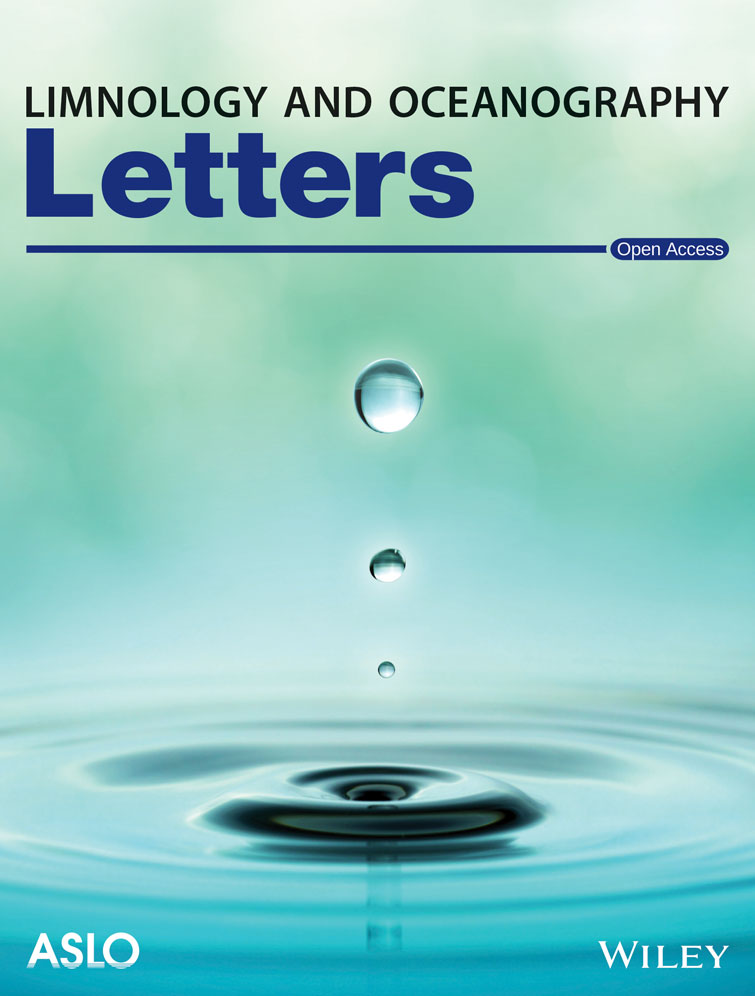Copepod‐associated microbial biogeography in the epipelagic ocean
IF 5
2区 地球科学
Q1 LIMNOLOGY
引用次数: 0
Abstract
Zooplankton‐microbial interactions play crucial roles in epipelagic ecosystem functions. The distinct west‐to‐east gradients and complex circulation patterns in the Mediterranean Sea, combined with the ubiquity of pelagic copepods, provide an ideal model to study the ecological processes driving host‐associated microbial spatial distribution. Here, we characterized and compared the copepod‐associated microbial metacommunities (CAMC) with those from seawater microbial metacommunities (SMC). Copepod‐associated microbial metacommunities displayed spatial dissimilarity between the western and eastern basins, while SMC exhibited similar microbial compositions. The within‐basin similarity observed in CAMC was associated with connectivity by the surface currents. Ecological drift explained most of CAMC variability, likely as a response to the restricted co‐dispersal of the hosts with their microbes, which presented low prevalence and abundance. Seawater microbial metacommunities displayed higher homogenizing dispersal, with widely distributed generalist taxa. We conclude that CAMC better reflect cross‐basin gradients and connectivity patterns than SMC, suggesting that CAMC may serve as a useful proxy for studying microbial biogeography.桡足类相关的上深海微生物地理
浮游动物与微生物的相互作用在上层海洋生态系统功能中起着至关重要的作用。地中海独特的西向东梯度和复杂的环流模式,加上无处不在的远洋桡足动物,为研究驱动宿主相关微生物空间分布的生态过程提供了理想的模型。本文对桡足类相关微生物元群落(CAMC)与海水微生物元群落(SMC)进行了表征和比较。东西部盆地桡足类相关微生物元群落存在空间差异,而SMC盆地微生物组成相似。在CAMC中观测到的盆地内相似性与表面流的连通性有关。生态漂移解释了CAMC的大部分变异,可能是对宿主及其微生物有限的共扩散的响应,而宿主的共扩散呈现出低流行度和丰度。海水微生物元群落表现出较高的均一化扩散,泛型类群分布广泛。我们认为CAMC比SMC更能反映跨流域梯度和连通性模式,这表明CAMC可以作为研究微生物生物地理学的有用代理。
本文章由计算机程序翻译,如有差异,请以英文原文为准。
求助全文
约1分钟内获得全文
求助全文
来源期刊

Limnology and Oceanography Letters
Multiple-
CiteScore
10.00
自引率
3.80%
发文量
63
审稿时长
25 weeks
期刊介绍:
Limnology and Oceanography Letters (LO-Letters) serves as a platform for communicating the latest innovative and trend-setting research in the aquatic sciences. Manuscripts submitted to LO-Letters are expected to present high-impact, cutting-edge results, discoveries, or conceptual developments across all areas of limnology and oceanography, including their integration. Selection criteria for manuscripts include their broad relevance to the field, strong empirical and conceptual foundations, succinct and elegant conclusions, and potential to advance knowledge in aquatic sciences.
 求助内容:
求助内容: 应助结果提醒方式:
应助结果提醒方式:


